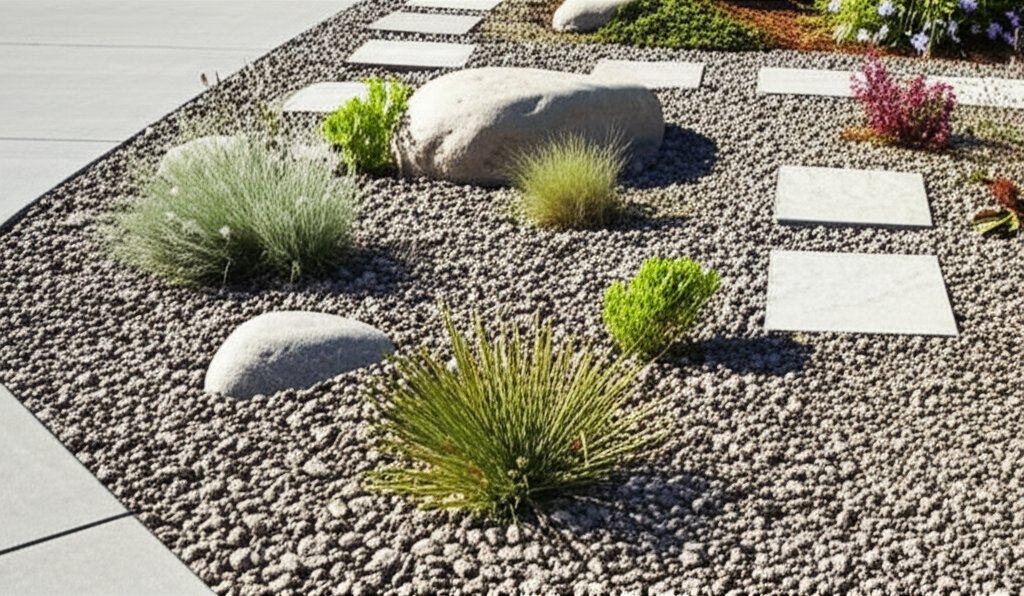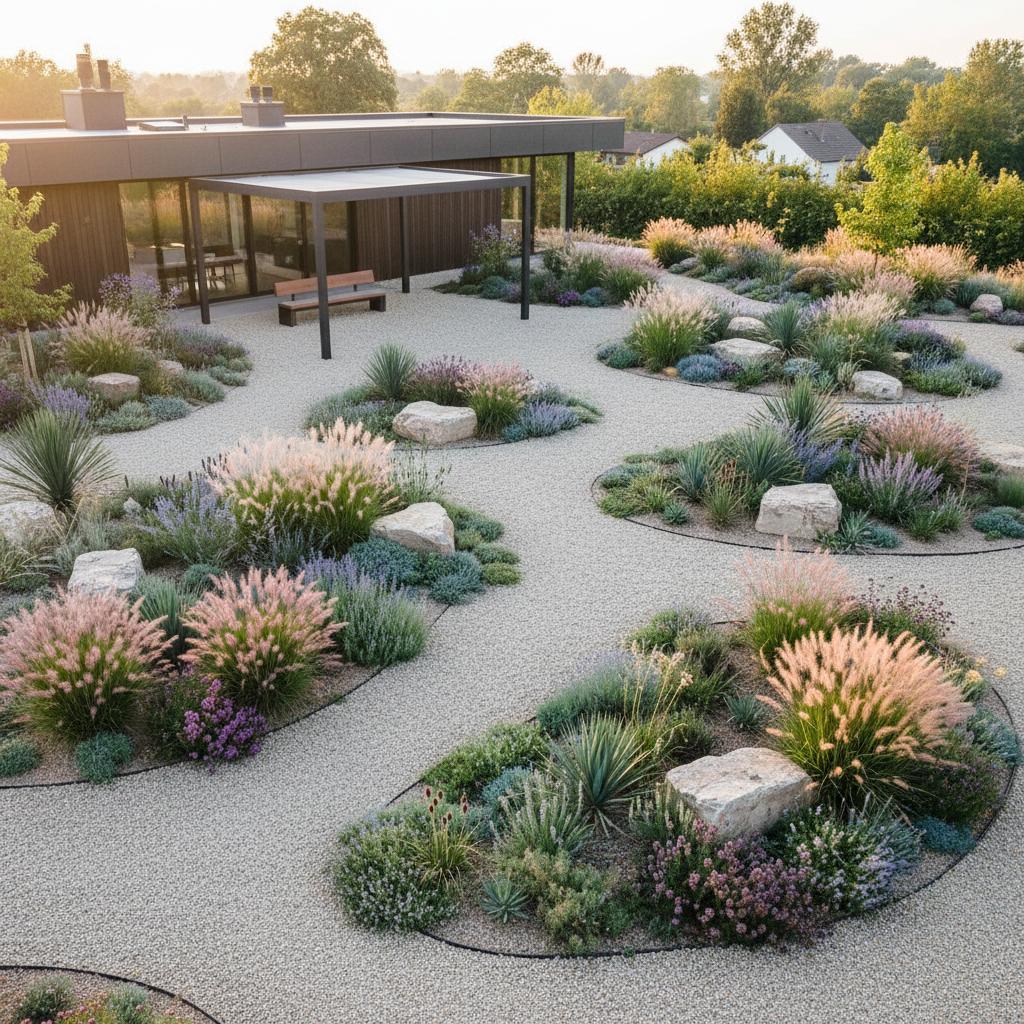Why Gravel Gardens Outshine Mulch in 2025 Landscaping
Homeowners often examine their gardens and recognize a need for greater tranquility, tidiness, and simplicity in care. Traditional mulch frequently demands more effort than it provides, as it fades, shifts, and decomposes quicker than anticipated. For those seeking a landscape that remains attractive and welcoming with minimal intervention, gravel gardens present an ideal solution.
Gravel gardens attract attention from individuals desiring aesthetic appeal alongside reduced maintenance. These designs introduce texture, equilibrium, and longevity to exterior areas in manners that mulch cannot replicate.
Assessing Your Landscape for Optimal Design
Start by conducting a deliberate inspection of your yard. Observe the patterns of sunlight across planting beds, identify zones where soil dries rapidly, and note areas that retain moisture or receive persistent shade. Such observations prove essential, as gravel gardens flourish when aligned with the inherent dynamics of the site.
Long-term mulch users may encounter irregular surfaces or hardened soil beneath the layers. Mulch occasionally retains surplus water, which fosters fungal issues or insect infestations. In contrast, gravel permits unobstructed movement of air and moisture. This adjustment revitalizes depleted soil and establishes a robust base for vegetation.
Durability Advantages of Gravel Over Mulch
A primary distinction between gravel and mulch lies in their longevity. Mulch commences breakdown shortly after application. Colors dull, and volume diminishes progressively, necessitating frequent replenishment to sustain neat appearances in beds.
Gravel maintains its form and hue for extended periods. Precipitation, gusts, and solar exposure exert minimal influence. When installed correctly, gravel remains secure and retains a refined look across seasons.
Selecting gravel minimizes post-storm disruptions. Mulch risks displacement or aggregation during heavy rains, whereas gravel distributes uniformly. It preserves accessible pathways, clear borderlines, and safeguards for plant roots.
To select appropriate gravel, consider particle size: finer varieties suit delicate plantings, while larger stones enhance stability in high-traffic zones. Local suppliers often recommend types based on regional climate, ensuring compatibility with freeze-thaw cycles or intense sun.
Building a Supportive Gravel Ecosystem
A gravel garden extends beyond mere stone placement; it forms an integrated framework that nurtures plants adapted to local conditions. Species such as drought-resistant perennials, decorative grasses, and succulents excel in gravel settings due to superior drainage paired with secure root anchorage.
Follow these structured steps to establish your garden:
- Clear the area by extracting weeds and aerating the upper soil layer to promote root penetration.
- Install a permeable weed-suppressing fabric to block invasive growth while allowing water passage.
- Distribute gravel uniformly at a depth of 2 to 4 inches, adjusting for aesthetic and functional needs.
- Integrate plants strategically, providing adequate spacing for maturation and ventilation to deter disease.
This methodical approach simplifies ongoing care. Time shifts from weed removal or material additions toward appreciation of the garden's evolving charm.
Incorporate companion planting for added resilience: pair gravel with ground covers like creeping thyme, which suppress weeds naturally while adding subtle fragrance and color.
Versatile Aesthetics Tailored to Your Vision
Gravel offers diverse options in coloration and granularity. Neutral beige variants infuse warmth into informal cottage-style gardens, whereas polished gray stones complement contemporary designs. Combining different sizes and tones introduces dimension and character devoid of disorder.
Employ gravel as a cohesive feature throughout the property. Outline walkways with it, border water features, or cover expansive beds. The uniform grain fosters a soothing cadence in the landscape, an effect mulch seldom delivers.
Pairing gravel with indigenous or water-efficient flora yields cohesive visuals that appear organic yet deliberate. The interplay of resilient stone against supple greenery captivates attention and encourages serene outdoor experiences.
For enhanced personalization, experiment with patterns: create mosaic effects in patios or radial designs around focal plants to elevate visual interest without complexity.
Practical and Environmental Advantages
Gravel gardens deliver aesthetics alongside functionality. They enhance water flow, mitigate soil erosion, and decrease reliance on synthetic fertilizers or herbicides. Since gravel avoids decomposition, it neither nourishes weeds nor disrupts soil chemistry.
This consistency bolsters vigorous root development and fortifies the garden against arid conditions or deluges. Gradually, observe reduced upkeep requirements, diminished expenses on supplies, and a more harmonious yard ecosystem.
Environmentally, gravel conserves resources: its permanence cuts down on annual replacements, reducing waste and transportation emissions compared to mulch production. It also supports pollinators by providing stable habitats for nectar-rich plants.
Sustaining and Enjoying Your Gravel Garden
With installation complete, upkeep proves straightforward. Periodic raking ensures a level surface, and a gentle hose application removes debris or residue. Established plants in gravel typically demand sparse irrigation, enabling nature to assume primary stewardship.
As seasons progress, the gravel garden consistently provides visual and tactile rewards. The subtle sound of footsteps on stones, the play of light on surfaces, and the reliable advancement of flora cultivate an environment that feels anchored yet vibrant.
Gravel gardens transcend fleeting styles; they embody a commitment to enduring outdoor environments that honor temporal constraints, labor investments, and ecological principles. Opting for gravel instead of mulch affirms choices in resilience, poise, and tranquility. The result transforms a simple yard into an evolving sanctuary that accompanies life's rhythms across years.



